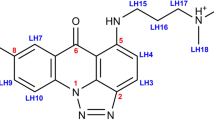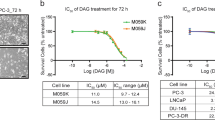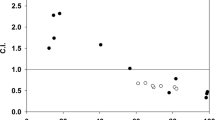Abstract
The cellular pharmacology of a series of C8-linked pyrrolobenzodiazepine dimers with polymethylene linkers of n = 3-6 (compounds 1-4) has been studied in a range of human tumour cell lines. The four compounds showed the same pattern of relative activity in five ovarian carcinoma cell lines and one cervical carcinoma cell line with the order of IC50 values of 1 < or = 3 < 4 < 2, which correlated with the previously demonstrated DNA interstrand cross-linking ability of the compounds in plasmid DNA. In human leukaemic K562 cells the agents produced a block in the G2/M phase of the cell cycle characteristic of cross-linking drugs, and extensive interstrand cross-linking was observed in cells by alkaline elution with no evidence of single-strand breaks. Cross-links continued to increase up to 24 h following a 1 h exposure to drug, and no repair was evident by 48 h. In a series of ovarian and cervical carcinoma cell lines with acquired resistance to cisplatin no cross-resistance to the most potent compound 1 was observed in two lines whose major mechanism of resistance to cisplatin was reduced platinum transport. Cross-resistance to 1 was observed in a cell line (A2780cisR) possessing elevated glutathione, and depletion of intracellular glutathione using D,L-buthionine-S,R-sulphoximine (BSO) from 10.25 nmol to 2.8 nmol 10(-6) cells reduced the level of resistance from 11-fold to 2-fold compared with sensitive cells. Cross-linking in the resistant cells was restored to 80% of the level in the parent line by BSO pretreatment. There was also a correlation between glutathione levels and sensitivity to 1 measured in several other ovarian cell lines. Compound 1 also showed cross-resistance in the doxorubicin-resistant cell line 41MdoxR and partial cross-resistance in CH1doxR cells. Both these lines possess elevated levels of p170 glycoprotein. Following treatment with 6 microM verapamil, the resistance in these lines decreased almost 2-fold and 8-fold respectively.
This is a preview of subscription content, access via your institution
Access options
Subscribe to this journal
Receive 24 print issues and online access
$259.00 per year
only $10.79 per issue
Buy this article
- Purchase on Springer Link
- Instant access to full article PDF
Prices may be subject to local taxes which are calculated during checkout
Similar content being viewed by others
Author information
Authors and Affiliations
Rights and permissions
About this article
Cite this article
Smellie, M., Kelland, L., Thurston, D. et al. Cellular pharmacology of novel C8-linked anthramycin-based sequence-selective DNA minor groove cross-linking agents. Br J Cancer 70, 48–53 (1994). https://doi.org/10.1038/bjc.1994.248
Issue Date:
DOI: https://doi.org/10.1038/bjc.1994.248
This article is cited by
-
An update on antibody–drug conjugates in urothelial carcinoma: state of the art strategies and what comes next
Cancer Chemotherapy and Pharmacology (2022)
-
The clinical development of antibody–drug conjugates — lessons from leukaemia
Nature Reviews Clinical Oncology (2021)
-
Pre-clinical pharmacology and mechanism of action of SG3199, the pyrrolobenzodiazepine (PBD) dimer warhead component of antibody-drug conjugate (ADC) payload tesirine
Scientific Reports (2018)
-
DNA interstrand cross-linking and in vivo antitumor activity of the extended pyrrolo[2,1-c][1,4]benzodiazepine dimer SG2057
Investigational New Drugs (2012)
-
Pharmacokinetics, pharmacodynamics and metabolism of the dimeric pyrrolobenzodiazepine SJG-136 in rats
Cancer Chemotherapy and Pharmacology (2011)



